Antietam: Re-enacting a bloody 1862 US Civil War battle
- Published
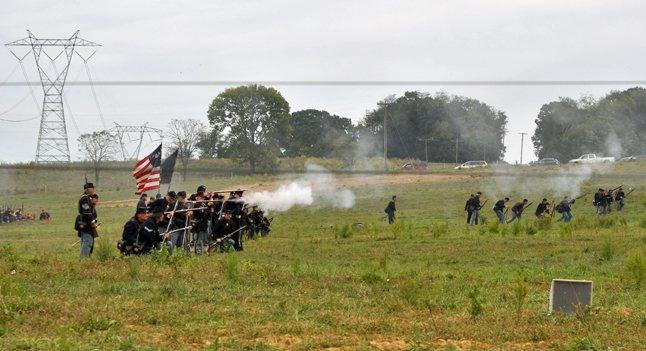
The uniforms and explosions seem real enough, but the power lines and cars detract from the effect
The Civil War Battle of Antietam was one of the bloodiest days in American history, with 23,000 dead, wounded or missing in a matter of hours. One hundred fifty years later, a group gathered to remember the battle - by re-enacting it.
The US Army artillery battery fires round after round dozens of feet from me, and within minutes my ears are ringing and the shock waves have made my heart flutter.
Across the battlefield squads of men in blue uniform line up just yards from others wearing grey. The sides exchange volleys of rifle and musket fire.
The air grows thick with smoke. Men fall to the ground.
The spectacle is dreadful, and anxiety washes over me.
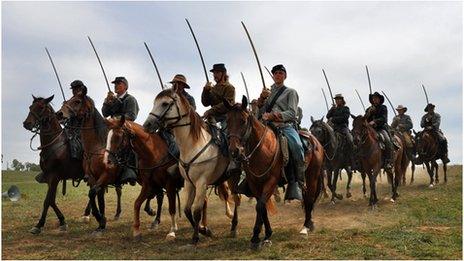
A troop of "Confederate" cavalry salute spectators as they ride off the battlefield
But the men are not really dead, of course. They're re-enacting a battle of the American Civil War, for their own amusement, while hundreds of spectators look on.
The Battle of Antietam took place 150 years ago last week near a small town in the state of Maryland, 55 miles (89km) from Washington DC.
It was one of the bloodiest days in American history, the standard against which September 11 was measured.
Twenty-three thousand Americans were killed, wounded or missing in the day-long battle. In proportion to today's population, that number would be 230,000.
The Battle of Antietam was a turning point in the Civil War between the Northern Union forces and the Southern Confederates, who had rebelled against the United States to preserve their right to hold African-American slaves in bondage.
Days after the battle, the Union victory emboldened President Abraham Lincoln to issue the Emancipation Proclamation, freeing the slaves held in the rebel states.
Last week, I drove to a field about two miles from the original Antietam battle ground to watch more than 4,000 hobbyists dressed in period kit march and fire blanks at one another with period weapons.
Civil war re-enactment is a huge American subculture, supporting a cottage industry of companies selling "authentic" uniforms, underpants, weapons and other kit.
It's an intense hobby - a lifestyle even, I'm told.
But 150 years ago one side took up arms defending slavery, the other to preserve the union. I'm keen to ask re-enactors on both sides what they make of that history.
After an hour the guns fall silent and a bugler plays taps, the traditional tune sounded at dusk and at military funerals. I approach the Rebel general, a steely eyed man clad in grey woollens accented with bright brass buttons, a forage cap cocked on his head.
Brian Gesuero is a firefighter by profession, from the state of Maryland. But that was a Union state during the war, I say. Two of his ancestors fought for the Rebels at the real Battle of Antietam, he answers.
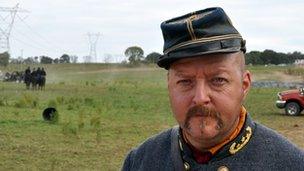
Brian Gesuero lives in a Union state - but portrays a Confederate general
How do he and other re-enactors on the rebel side grapple with slavery's inescapable role in the Civil War? I ask.
He bristles.
"Slavery has nothing to do with it," he answers. "These boys in grey were out there protecting their homes, their hearths and their sweethearts."
A nearby spectator overhears my question and calls out: "States' rights!"
It's a familiar slogan. A popular theory goes like this: "The Southern states left the Union in a dispute about the balance of power between them and Washington. The war couldn't really have been to defend slavery, as most southerners were too poor to own slaves."
Even today, conservatives invoke "state's rights" when Washington tells them to do something they don't want to.
Only now, the argument is not about whether states should ban or allow slavery, but about whether they should do as Washington says and, say, reform healthcare systems.
"The fundamental argument Americans are having now about the rights and purposes of government goes right back to the Civil War," says David Blight, a prominent Civil War historian at Yale University.
Back on the battlefield in Maryland, I leave the Rebel "general" and wander off toward the re-enactors' campground.
A group of men in Union Blue sit under a large canvas tent drinking from tin cups - and the occasional non-period beer can.
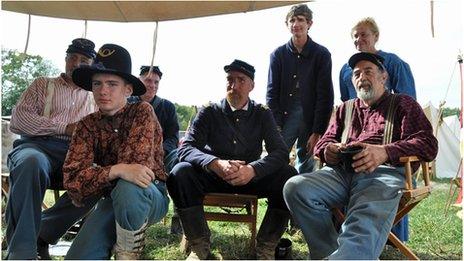
The Seventh Pennsylvania Infantry men are engineers, IT workers, students, a college professor, and more
They portray the Seventh Maryland Volunteer Infantry, they say.
In real life, a couple of the men are engineers, others work in IT or are students. There's a college professor and a man who repairs scales. Some of their wives have joined them at the camp - they're dressed in period costume, too.
To hear them explain it, Civil War re-enactment offers all the fun of Army life without the hardship. It's comradeship, smart uniforms, shiny kit, tent-camping under the stars - no tyrannical officers or forced marches, no disease or death.
"If it's all a game," I ask, "how do you decide who pretends to die?"
The men laugh. I'm told that's the classic question from the uninitiated.
If the other side fire a particularly good volley, the men answer, someone's got to drop. If you're tired from all the marching, die, take a rest, and watch the battle from the ground.
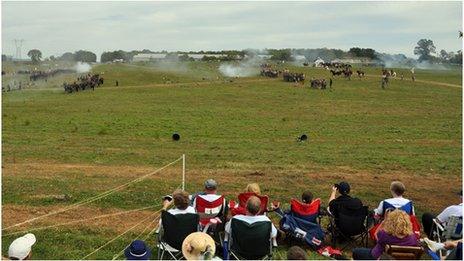
Spectators watch the re-enactment as if at a football match, but tastefully, they do not cheer
I myself am a northerner by birth and temperament, and, perhaps feeling a bit smug surrounded by fellow Yankees, I ask the men whether they feel morally superior to the guys who wear grey and pretend to fight for the Slave Power.
But they're too gentlemanly to taunt the losing side. After all, some of them had ancestors who fought for the rebels. So did I, in fact.
"We're all Americans," says Steve Giovannini, an engineer.
"We try to honour the memory of the men who fought for their values, whether we agree with them or not.
"Their struggle made our country."
How to listen to From Our Own Correspondent:
BBC Radio 4: A 30-minute programme on Saturdays, 11:30 BST.
Second 30-minute programme on Thursdays, 11:00 BST (some weeks only).
Listen online or download the podcast
BBC World Service:
Hear daily 10-minute editions Monday to Friday, repeated through the day, also available to listen online.
Read more or explore the archive, external at the programme website, external.
- Published4 April 2012
- Published18 February 2011